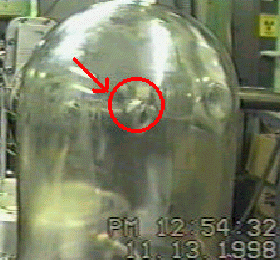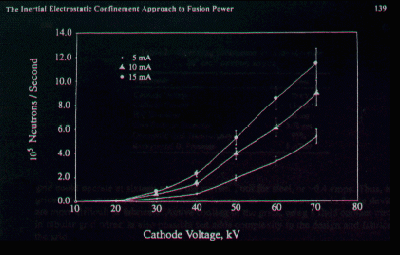Part II: Design Criteria
Table 1: ORIGINAL MINIMUM DESIGN CRITERIA (Blinking criteria
revised or unfulfilled)
1. The system be able to sustain prolonged vacuum < 10 mTorr.
3. The system be suitably shielded against implosion shrapnel.
6. The system be electrically insulated for an absolute minimum of 50kV.
7. Non-metallic vacuum hose be used.
8. All metal parts, mounts, chassis be grounded.
9. The electrodes be composed of a material which will readily release
electrons.
10. The electrodes be fabricated in a manner to withstand high temperature.
11. The electrodes be in a suitably geometric symmetry to optically focus
the ions.
12. That the Gaussian surface enclosed by each electrode be > 80% transparent.
13. That plasma confinement and ion re-circulation be attained.
OPTIONAL DESIGN CRITERIA (IFF DEUTERIUM FUSION IS TO OCCUR!)
16. Vacuum exhaust MUST be contained and/or filtered.
17. Suitable radiation detection equipment be used.
Table 2: REVISED, UNFULFILLED CRITERIA
2. The bell jar must be made of deep vacuum and high temperature material.
It is unknown whether or not the bell jar is made of boro-silicate (Pyrex,
Kimax) glass or not. Given a near disaster that occurred early on
in the experiment, it is dubious whether any glass bell jar at all is really
adequate. The electron beam from the cathode struck the bell jar
under a high pressure and power experiment. This is hardly surprising
in light of the fact that electron temperature can be found by multiplying
the voltage by 11,600 K/eV, the quotient of the potential energy of the
electron in Joules and Boltzmann's constant.
T = [1.61x10^-19 J/eV]/[1.38x10^-23 J/K] = 11,600 K/eV
This is how the Tokamak priesthood "snows" the public with outrageous
claims of temperatures of 200-300,000,000 K. Your television CRT
attains temperatures on the order of 60,000,000! In any event, it
is particle density which is more relevant to the amount of heat actually
transferred. At 45 microns and about 2kV, 50 mA, the bell jar was
nearly destroyed.

The problem of the electron beam is serious. The Farnworth-Hirsch
team used T-304 stainless steel vessels of about a 20" diameter at 6kVA,
pressures < 1 micron and periodically burned through their device walls.
The next version of this project will use a spherical copper dewar shell
as the vessel and anode. Granted, this doesn't solve the problem,
but at least metals can be welded.
4. The vacuum pump exhaust be suitably filtered and/or vented.
This is in fact only of concern if fusion is to be attained.
5. A variable power supply must provide a potential > 15kV at a current
0 < I < 150 mA. Much lower currents, 5 < I <
15 mA, have been used at high voltages, V > 20kV with success. A
plot of Dr. Miley's device output as a function of V and I is given below.

14. The system be suitably shielded for X, G rays and fast neutrons. (X-rays
might occur even with air at high voltage.) This has only
recently become a valid issue, now that the 60kV Sorenson Model #1061 supply
is on line. For merely validitating confinement, the glass walls
of the bell jar have been quite sufficient to stop the low energy X rays
generated.
15. A pulse valve be used to introduce D2 gas to the system. Nice
but not really necessary. One must backfill back up to 200-400 microns
pressure initially to get enough residual impurities out of the system
before a "fusion pure" atmosphere can really be attained. Once this
has occurred, a pulse valve is an efficient way to introduce more gas to
the system.



